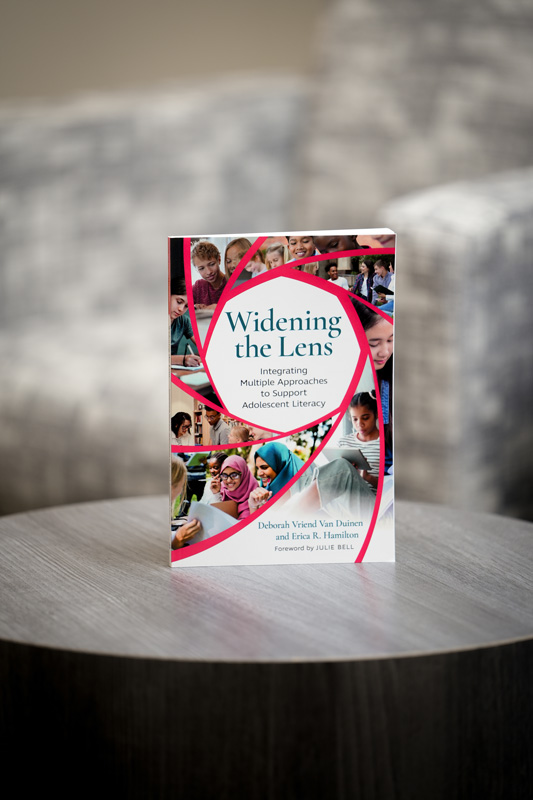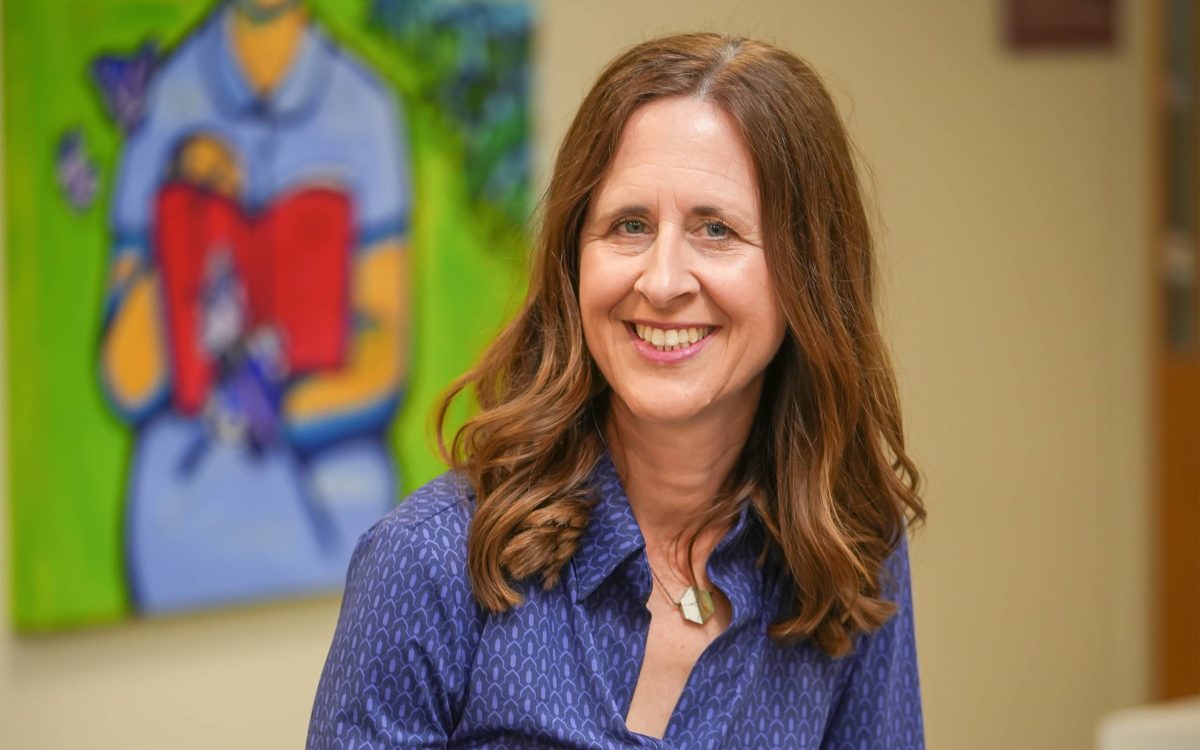Some Building Blocks of Literacy Lie Outside the School Walls
Dr. Deborah Van Duinen, the Arnold and Esther Sonneveldt Professor of Education
Literacy is more complicated, diverse and holistic than meets the eye. That’s why, according to Dr. Deborah Van Duinen, there’s a need to widen the lens through which parents, teachers and others view adolescents and their literacy alike.
That’s the premise of her new book written with Dr. Erica R. Hamilton of Grand Valley State University, Widening the Lens: Integrating Multiple Approaches to Support Adolescent Literacy. Suffused with the experiences of teachers and students (and many who consider themselves to be both), it was written to be the book she and Hamilton wish they’d had when they began teaching.
“A broader understanding of literacy allows us to recognize, affirm and value our students as holistic beings,” says Van Duinen, who is the Arnold and Esther Sonneveldt Professor of Education. “I want to equip all students to be proficient and to do well in academic literacy skills, but I want to do it in this larger landscape where we recognize academic literacy isn’t the only standard. There are other ways to be literate.”
“A broader understanding of literacy allows us to recognize, affirm and value our students as holistic beings… I want to equip all students to be proficient and to do well in academic literacy skills, but I want to do it in this larger landscape where we recognize academic literacy isn’t the only standard. There are other ways to be literate.”
She had a front row seat for many of them as a high school English teacher before joining Hope’s Department of Education in 2010. A student may slump glumly into a classroom, certain he doesn’t like reading — keen to just get back to his automotive manuals. Another might dread tackling a novel, but avidly peruse reams of text on her favorite nature website. Unbeknownst to them, these students are engaging in literacy. Discovering that fact “gives students language to see what they’re good at, what makes their hearts sing,” Van Duinen says.
Her book with Hamilton proposes ways to help students transfer some of those skills into the classroom.
“How might we help a student realize that they are more than the ‘D’ they received in an English class? Literacy is identity; we internalize a lot of the messages we’ve received over time about our reading and writing skills,” Van Duinen says. Acknowledging and honoring skills gained and interests pursued outside school transcends mistaken identities; the “bad reader” learns he’s been reading — and enjoying it — all along.
“Motivation is huge,” Van Duinen explains. “If you’re not engaged and motivated, we can do all the skill development we want, but it’s not going to stick.”
Literacy education, in a widening-the-lens approach, is about beginning with the assets students bring from their own experiences and interests. It means “welcoming newcomers in and thinking back to what it was like to learn something for the first time,” says Van Duinen.
“Literacy development is ongoing, throughout our lives,” she adds. “We all learn new literacy skills based on the different contexts we find ourselves in, such as our workplace, school, or cultural or religious settings.”
Our conception of literacy particularly needs to evolve in the face of the AI revolution, Van Duinen explains. Because of artificial intelligence, “we cannot be literate in the ways we were 10 years ago, 50 years ago. There are new skills that we have to be learning and developing,” she says. “In my literacy field, we’re trying to figure out what being AI literate means.” Van Duinen is exploring that question this year while on sabbatical.

“Hope’s vision is that our research and scholarship inform and shape our teaching, and our teaching shapes and informs our research,” she says. “That’s been one of the most fun parts of this job. As Erica and I were writing this book, my students’ voices — their questions, the bumps they had in their learning — were constantly shaping what we chose to write and how we chose to write about it.”
While it might not be everyone’s favorite flavor of literacy, there’s something to be said for getting lost in a good book. That’s an impetus behind Van Duinen’s more traditional reading initiative: Big Read Lakeshore. The annual community-wide program has been engaging the public around the love of reading in three West Michigan counties since Van Duinen founded it in 2014.
“Hope’s vision is that our research and scholarship inform and shape our teaching, and our teaching shapes and informs our research… That’s been one of the most fun parts of this job. As Erica and I were writing this book, my students’ voices — their questions, the bumps they had in their learning — were constantly shaping what we chose to write and how we chose to write about it.”
Each year Van Duinen selects a Big Read book with input from professors, librarians, teachers and community members. She then selects a complementary Middle Read book (for middle schoolers), Little Read book (for elementary schoolers), and Mini Read book (for infants to preschoolers). The latter three were developed from grassroots community feedback about opening the initiative to even more people. The Mini Read, the latest addition, debuted in 2023. Each November, in many public schools along the lakeshore and in adult gatherings, Big Read events bring people together to discuss the books. This fall features the oldest yet selected: The Great Gatsby. The Middle Read selection is Pedro Martín’s Mexikid; the Little Read’s focus is Dreamers, by Yuyi Morales’ and the Mini Read book is Love: A Celebration of Mindfulness, by Katie Wilson. The themes uniting them: the concept of belonging and how to flourish together as a community — particularly apropos, Van Duinen says, for an election year.
“It’s never too early to start the love of reading books or build up a literacy culture in the home,” Van Duinen says.
That said, the Big Read is not solely — or even primarily — about the books themselves.
“It’s what the book allows us to do together. There’s power in coming together around a shared book. We can connect over favorite characters or plotlines or topics or symbols,” Van Duinen says. It’s about community, belonging, and fostering a space that bridges demographic and ideological divides. “We might not agree on political or religious issues, but we can come together as readers, and together we can listen to and learn from one another.”

